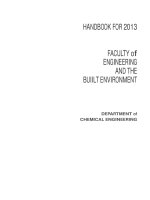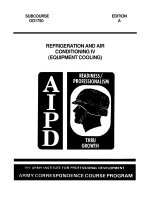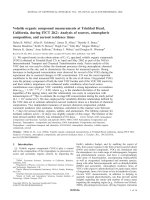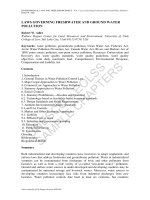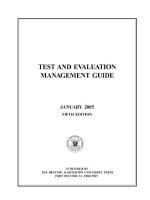SYLLABUS MANUAL TRANSMISSIONS AND DIFFERENTIAL AXLES AUTO-1290 pot
Bạn đang xem bản rút gọn của tài liệu. Xem và tải ngay bản đầy đủ của tài liệu tại đây (29.12 KB, 11 trang )
SYLLABUS
MANUAL TRANSMISSIONS
AND DIFFERENTIAL AXLES
AUTO-1290
2009
WESTERN NEBRASKA COMMUNITY COLLEGE
DIVISION OF APPLIED TECHNOLOGIES
I. CATALOG DESCRIPTION:
AUTO-1290
Manual Transmissions and Differential Axles
Prerequisite: None
This course emphasizes the drive train system, including the theory and shop
practice of automotive, commercial, and agriculture vehicles. Manual
transmission/transaxle, clutch assembly, differential axle, drive shaft/u-joint, four
wheel drive/ all-wheel drive used in automobile, commercial and agricultural
vehicles are explained. Students may supply shop work, but it is not mandatory.
Offered fall semester only.
(3/30/45/0/0/5)
II. COURSE OBJECTIVES/COMPETENCIES:
A. To develop in each student, safe, clean work habits, attitudes and skills.
B. To provide information concerning the vocational opportunities offered by this
area of technological development
C. To teach the student to learn by doing under conditions similar to those in
business.
D. To teach the student to learn to work effectively with others
E. To develop knowledge of correct nomenclature of tools and automobile,
commercial and agricultural parts
F. To teach the student to analyze
G. To give the student the knowledge and understanding necessary to accept a
job
H. To train the student in using correct lab techniques and equipment usage
resulting in an intelligent and effective application of these skills in the
performance of assigned duties.
III. INSTRUCTIONAL MATERIALS:
A. Textbook
1. James D. Halderman. Automotive Technology Principles, Diagnosis
and Service. 3rd Edition. ISBN 978-0-13-175477-5
B. Required References:
MANUAL TRANSMISSIONS AND DIFFERENTIAL AXLES
AUTO-1290
2
1. Motors Repair Manuals
2. Chilton Repair Manuals
3. Mitchell Repair Manuals
4. Manufacturers Shop Manuals
C. Visual Aides:
1. Films
2. Video tapes, CD, & DVD
3. Demonstration by instructor
4. Field trips to industry
5. Charts
IV. COURSE OUTLINE:
A. Approximate Breakdown
B. Tools
C. Special purpose tools
D. Measuring tools
E. Fastening devices and tube fittings
F. Clutch assembly
G. Manual transmissions
H. Differential axles
I. Drive shaft and U-joints/half shaft and C.V. joints
J. Four-wheel drive/All-wheel drive components
V. SPECIFIC COURSE REQUIREMENTS:
A. Specific Instruction
1. Shop safety
a) Safe behavior in the shop
MANUAL TRANSMISSIONS AND DIFFERENTIAL AXLES
AUTO-1290
3
b) Power equipment in operation
c) Shop tour
2. Tools-Correct Use and Proper Names
a) Screwdrivers
b) Wrenches
c) Hammers
d) Chisels and punches
e) Files
f) Drill bits
g) Drills
h) Reamers
i) Saws and blades
j) Taps and dies
k) Cleaning tools
l) Pliers
3. Special Purpose Tools
a) Manual Transmission /Drive Train Tools
(1) Bearing pullers
(2) Bearing separators
(3) Gear pullers
(4) Dial indicator
(5) Clutch alignment
(6) U-Joint press
(7) Slide hammer
(8) Half shaft puller
MANUAL TRANSMISSIONS AND DIFFERENTIAL AXLES
AUTO-1290
4
(9) C.V. joint boot pliers
(10)Pinion depth/ differential set-up gauge
b) Measuring Tools
(1) Feeler gauges
(2) Micrometers
(3) Caliper
(4) Dial indicator
(5) Torque wrench (inch pound, foot pound)
c) Fastening Devices
(1) Bolt and head sizes (types of thread and classification)
(2) Washers (flat, locking, star, etc.)
(3) Cotter pins, snap rings, retainer rings
4. Standard Transmissions and Clutches
a) Torque multiplication
b) Shift mechanisms
c) 2 speed
d) 3 speed
e) 4 speed
f) 5 speed
g) With overdrive
h) Clutches
(1) Mechanical linkage
(2) Hydraulic
(3) Cable
5. Differential Axles
MANUAL TRANSMISSIONS AND DIFFERENTIAL AXLES
AUTO-1290
5
a) Construction
b) Axle types
c) Differentials
d) Adjustments
e) Anti-slip differentials
f) Hypoid gears
g) Spiral gears
h) Spur gears
i) Gear ratio
j) Planetary gear differentials
k) Lubrication
l) Gear
6. Propeller shafts
a) Universal joints
b) Slip joints
c) Hotchkiss drive
d) Torque drive
e) Constant velocity joints
f) Shaft alignment
g) Shaft vibrations
7. Four-Wheel Drive/All-Wheel Drive Components
a) Locking/automatic hubs
b) Part time
c) Full time
d) All wheel drive
MANUAL TRANSMISSIONS AND DIFFERENTIAL AXLES
AUTO-1290
6
VI. Competency Task List
A. General Drive Train Diagnosis
1. Complete work order to include customer information, vehicle
identifying information customer concern, related service history cause,
and correction.
2. Identify and interpret drive train concern; determine necessary action.
3. Research applicable vehicle and service information, such as drive
train system operation, vehicle service history, service precautions,
and technical service bulletins
4. Locate and interpret vehicle and major component identification
numbers.
5. Diagnose fluid loss, level, and condition concerns; determine
necessary action.
6. Drain and fill manual transmission/transaxle and final drive unit.
B. Clutch Diagnosis and Repair
1. Diagnose clutch noise, binding, slippage, pulsation, and chatter
problems; determine needed action.
2. Inspect clutch pedal linkage, cables, automatic adjuster mechanisms,
brackets, bushings, pivots, and springs; perform necessary action.
3. Inspect hydraulic clutch slave and master cylinders, lines, and hoses;
determine necessary action.
4. Inspect and replace clutch pressure plate assembly, clutch disc,
release (throw-out) bearing and linkage, and pilot bearing/bushing (as
applicable).
5. Inspect flywheel and ring gear for wear and cracks; determine
necessary action.
6. Inspect engine block, core plugs, rear main engine oil seal, clutch (bell)
housing, transmission/transaxle case mating surfaces, and alignment
dowels; determine necessary action.
C. Transmission/Transaxle Diagnosis and Repair
1. Remove and reinstall transmission/transaxle.
MANUAL TRANSMISSIONS AND DIFFERENTIAL AXLES
AUTO-1290
7
2. Disassemble, clean, and reassemble transmission/transaxle
components.
3. Inspect transmission/transaxle case, extension housing, case mating
surfaces, bores, and vents; perform necessary action.
4. Diagnose hard shifting, jumping out of gear, concerns; determine
necessary action.
5. Inspect, adjust, and reinstall shift linkages, brackets, bushings, cables,
pivots, and levers.
6. Inspect and reinstall powertrain mounts.
7. Inspect and replace gaskets, seals, and sealants; inspect sealing
surfaces.
8. Inspect, adjust, and install shift cover, forks, levers, grommets, shafts,
sleeves, detent mechanism, interlocks, and springs.
9. Measure endplay or preload (shim or spacer selection procedure) on
transmission/transaxle shafts; perform necessary action.
10. Inspect and reinstall synchronizer hub, sleeve, keys (inserts), springs,
and blocking rings.
11. Inspect lubrication devices (oil pump or slingers); perform necessary
action.
12. Inspect, test, and replace transmission/transaxle sensors and
switches.
D. Drive Shaft and Half Shaft, Universal and Constant-Velocity (CV) Joint
Diagnosis and Repair
1. Diagnosis constant-velocity (CV) joint noise and vibration concerns;
determine necessary action.
2. Diagnose universal joint noise and vibration concerns; perform
necessary action.
3. Remove and replace front wheel drive (FWD) front wheel bearing.
4. Inspect, service, and replace shafts, yokes, boots, and C.V. joints.
5. Check shaft balance, and phasing; measure shaft runout; measure and
adjust driveline angles.
E. Drive Axle Diagnosis and Repair
MANUAL TRANSMISSIONS AND DIFFERENTIAL AXLES
AUTO-1290
8
1. Diagnose noise and vibration concerns; determine necessary action.
2. Diagnose fluid leakage concerns; determine necessary action.
3. Inspect and replace companion flange and pinion seal; measure
companion flange runout.
4. Inspect ring gear and measure runout; determine necessary action.
5. Remove, inspect and reinstall drive pinion and ring gear, spacers,
sleeves, and bearings.
6. Measure and adjust drive pinion depth.
7. Measure and adjust drive pinion bearing preload.
8. Measure and adjust side bearing preload and ring and pinion gear total
backlash and backlash variation on a differential carrier assembly
(threaded cup or shim types)
9. Check ring and pinion tooth contact patterns; perform necessary
action.
10. Disassemble, inspect, measure, and adjust or replace differential
pinion gears (spiders), shaft gears, side bearings, thrust washers, and
case.
11. Reassemble and reinstall differential case assembly; measure runout;
determine necessary action.
F. Limited Slip Differential Diagnosis and Repair
1. Diagnose noise, slippage, and chatter concerns; determine necessary
action.
2. Clean and inspect differential housing; refill with correct lubricant
and/or additive.
3. Inspect and reinstall limited slip differential components.
4. Measure rotating torque; determine necessary action.
G. Drive Axle Shaft
1. Diagnose drive axle shafts, bearings, and seals for noise, vibration,
and fluid leakage concerns; determine necessary action.
2. Inspect and replace drive axle shaft wheel studs.
MANUAL TRANSMISSIONS AND DIFFERENTIAL AXLES
AUTO-1290
9
3. Remove and replace drive axle shafts.
4. Inspect and replace drive axle shaft seals, bearings, and retainers.
5. Measure drive axle flange runout and shaft end play; determine
necessary action.
H. Four-wheel Drive/All-wheel Drive Component Diagnosis and Repair
1. Diagnose noise, vibration, and unusual steering concerns; determine
necessary action.
2. Inspect, adjust, and repair shifting controls (mechanical, electrical, and
vacuum), bushings, mounts, levers, and brackets.
3. Remove and reinstall transfer case.
4. Disassemble, service, and reassemble transfer case and components.
5. Inspect front-wheel bearings and locking hubs; perform necessary
action.
6. Check drive assembly seals and vents; check lube level.
VII. METHOD OF PRESENTATION:
A. Method of instruction includes individual and group demonstrations.
B. Work in the lab and classroom correlated. The student is first told and shown
why and how a mechanism works. He/she then goes to the lab verifies what
was seen and heard in lecture. All repair, overhaul and other service work is
likewise preceded by classroom lecture and demonstration. There is little
time lapse between classroom presentation and related lab work; the student
applies the theory before it has had a chance to grow stale in the mind.
VIII. METHOD OF EVALUATION:
A. Regular attendance is a must because performance in the lab under actual
working conditions is stressed
B. Quality of work
C. Quantity of work
D. Effort and attitude to include:
1. Cooperation with group and instructor
2. Care and use of equipment
MANUAL TRANSMISSIONS AND DIFFERENTIAL AXLES
AUTO-1290
10
3. Organization and pride in work.
4. General courtesy and respect for rule and general situation in the lab.
5. Observation of safety factors
6. Respect for other students and their work.
7. Thriftiness in use of materials and equipment
E. Tests are given at frequent intervals. Two types of tests are given - practical
in lab and written in classroom.
F. Final grade will be determined by the following criteria:
1. Quality and quantity of work
2. Effort and attitude
3. Testing - practical and written
IX. ACADEMIC INTEGRITY:
Academic integrity forms a fundamental bond of trust between colleagues, peers,
teachers, and students, and it underlies all genuine learning. At WNCC, there is
no tolerance for plagiarism or academic dishonesty in any form, including
unacknowledged "borrowing" of proprietary material, copying answers or papers,
or passing off someone else’s work as one's own. Such acts are reported to the
appropriate authorities
A breach of ethics or act of dishonesty can result in:
• failure of a paper or exam within a course
• failure of an entire course (blatant plagiarism, cheating on a test or quiz)
• academic suspension or expulsion from the college
X. EQUAL ACCESS STATEMENT:
Western Nebraska Community College is committed to providing reasonable
accommodation to persons with disabilities. If you qualify under the Americans
with Disabilities Act (ADA), please notify the Director of Counseling, 308-635-
6090, as soon as possible to begin the process of documentation review and
determination of appropriate accommodation or adaptive strategies.
10-28-09


